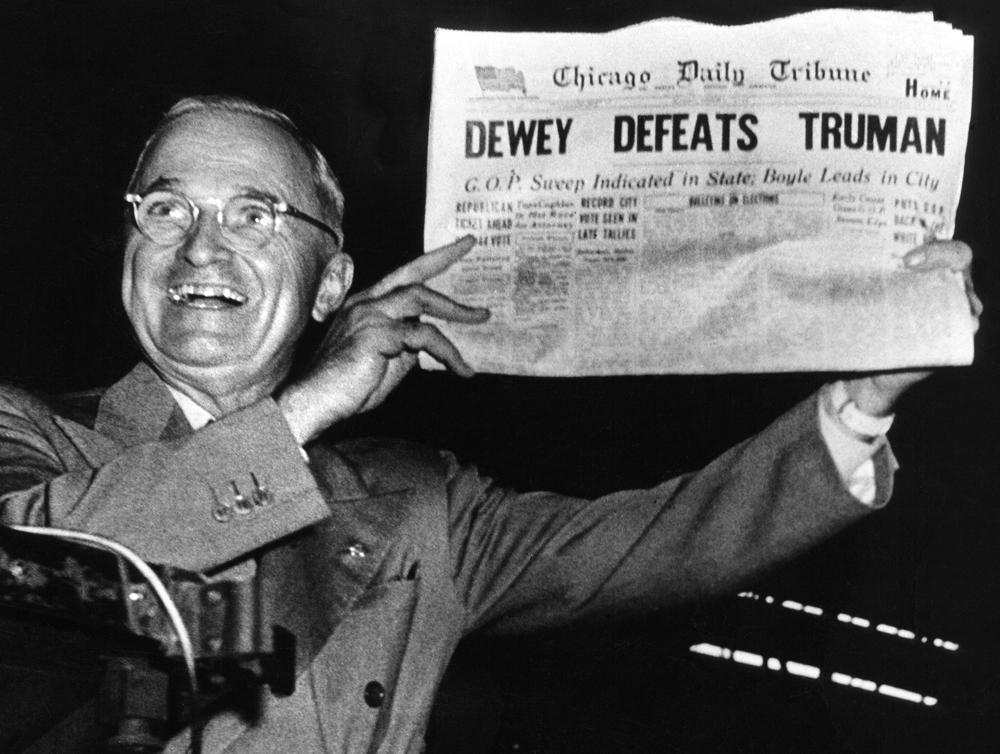Thomas G. Mitchell, “The Self-Hating Gentile,” follows up his thoughts on Rashid Khalidi’s The Iron Cage with this review of Genesis: Truman, American Jews, and the Origins of the Arab/Israeli Conflict by John B. Judis. (Readers may also want to see Paul Scham’s review of the Judis book.)
 |
| David Ben-Gurion and Abba Eban present a gift to Harry Truman in 1951. |
Veteran journalist John Judis, a longtime contributor to The New Republic, is an admirer of the cultural Zionism of Ahad Ha’am (Asher Ginsberg), who was a critic of Theodore Herzl and political Zionism. Judis has written a history of the early Palestinian-Zionist conflict and American involvement in it. It consists of three parts: the story of Zionism and Palestinian nationalism through 1939, the origins of American Zionism from the 1890s to World War II, and the Truman administration’s policy on Palestine from 1945 to 1948. It quickly becomes clear that Judis is not a Zionist at all.
Judis also provides a brief history of Reform Judaism, currently the largest Jewish denomination in the U.S. Reform Judaism is often seen as imitating Protestant Christianity by rejecting many traditional Jewish rituals, including most prayers in Hebrew, and the behavioral restrictions inherent in observing Halakha (religious law), in favor of a values-driven ethical creed, derived largely from the Jewish Prophets. It was launched first in Germany, and then in North America and Britain, in order to make the religion seem more like its Christian counterparts and thereby facilitate Jewish cultural assimilation. In doing so, Reform also jettisoned the ethnic-national component of traditional Judaism, to forestall accusations of dual loyalty. Thus, when Zionism was imported to America, it confronted a large community of Jews that rejected Jewish nationalism.
Judis then gives us a history of Zionism in America, starting with the Hovevei Zion (“Lovers of Zion”) clubs on the East Coast in the 1880s and ‘90s, followed by new chapters that sprang up spontaneously in reaction to the publication of Herzl’s The Jewish State. Following Herzl’s death, the movement went into hibernation until World War I. Judis then recounts the story of Louis Brandeis who helped win important support from President Wilson for the Balfour Declaration. Judis also discusses Rabbi Stephen Wise and the Zionist Organization of America. This section concludes with a chapter on Rabbi Abba Hillel Silver. He accuses these three early American Zionist leaders of hypocrisy for being liberals in American politics but unsympathetic toward Palestinian self-determination. (Both rabbis were at odds with the non-Zionist majority of their fellow Reform Jews at the time.) He also notes that they identified publicly with the moderate Jewish Agency, but supported the territorial maximalism of the Revisionist Zionists led by Ze’ev Jabotinsky and Menahem Begin.
Judis’s main thesis is that American Zionist leaders lobbied Truman and exploited his electoral vulnerability in the 1948 election to pressure him into a pro-Zionist policy during Israel’s War of Independence that same year. Readers will remember that this was the very close election in which Truman was photographed with a copy of the Chicago Tribune bearing the headline “Dewey Defeats Truman.” Truman won the election thanks to a whistlestop train tour across the country that was financed by a Jewish fund raiser.
Palestinians should read the chapters on the 1948 election campaign and the 1948 war as an education on how to pick the lock of Rashid Khalidi’s “iron cage.” The Jews proved themselves a nation in 1948, while the Palestinians proved that they were not yet at that stage.
Judis argues that if it were not for this pressure by American Jews that caused Truman to tilt towards the Jews, war could have been avoided. This is nonsense! Even Rashid Khalidi argues in The Iron Cage that given the rise of Hitler in Germany, war was inevitable in Palestine.
Judis mentions a visit by Judah Magnes to Truman in 1948 urging him to support peace in Palestine. Both the dean of Israel’s new historians, Benny Morris, in his 2009 volume, One State, Two States, and Israeli-American historian Walter Laqueur in his 2006 book, Dying for Jerusalem, discuss the history of binationalism in Palestine. American Reform rabbi and cultural Zionist Judah Magnes, who served as the first president of the Hebrew University of Jerusalem, founded Brit Shalom (Peace Alliance) as a discussion group in the mid-1920s. It consisted of about a hundred German Jews in the Jerusalem neighborhood of Rehavia. The Arab Revolt caused Brit Shalom to disappear. Magnes revived it in 1942 as Ihud (Union). The group came out in favor of binationalism and even persuaded the HaShomer HaTzair kibbutz movement to adopt this objective in the mid-1940s. But virtually no Arabs supported binationalism. A minor member of the al-Husseini clan signed a petition circulated by Ihud, probably out of friendship for Magnes, and paid for it when clan leader Jamal al-Husseini ordered his assassination. In 1948, HaShomer HaTzair merged with another party to form Mapam and came out in favor of Israeli independence.
Judis has an 18-page afterword in which he updates American policy from 1949 to 2013 with an emphasis on the rise of AIPAC and Obama’s Mideast policy from 2009 to 2013. He predicts that nothing will come of the present peace initiative, and demonstrates that Obama has already modified his policy from 2009 in reaction to pressure from AIPAC, thus repeating the pattern that Judis claimed was true for Truman from 1945-48. Thus Judis echoes Khalidi’s pessimistic conclusion regarding the two-state solution. Judis’s book is worth reading for his section on American Zionism and for his realistic afterword. But for the history of the 1948 war, I suggest Howard Sachar’s 1997 work, A History of Zionism.





Leave A Comment